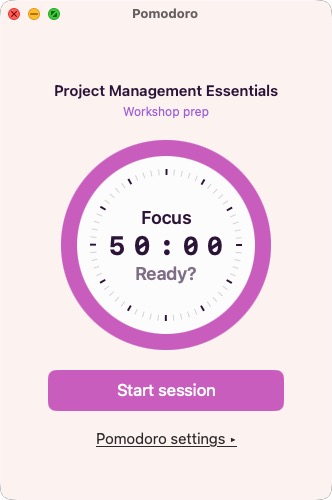When I run project management workshops, there’s always one problem that everyone struggles with: how on earth do you estimate the time needed for each task? Most of us either overlook the complexities of an apparently straightforward activity, or simply forget that it always takes much longer than we imagine. As researchers, we vow to devise a better data-driven solution, but that’ll be for the next project.
Time Tracking
One of the best solutions I’ve discovered is time tracking. Working on freelance projects, I sometimes need to track billable hours for clients. With time tracking tools like Toggl, you record the start and end time for activities so you can generate reports on exactly how long you spent on that project. Within the project, you use tags or labels to track specific activities, such as emails, meetings, or researching. I use Toggl1 because it’s easy record everything with the desktop timer, which also supports the Pomodoro Technique. Alternatives include Clockify and RescueTime.

I soon realised that routinely tracking my non-billable time provides many useful insights:
Avoiding Procrastination
I often put off unattractive tasks on the basis of “I don’t have time to do this now.” Embarrassingly, time tracking shows me that many of these mammoth tasks take less than 10 minutes 😬
Of course, time tracking also reveals the opposite problem: those tasks that really do take ages. Email is a common culprit. We put too much energy into vanquishing that inbox at the expense of our more important activities - a sneakier form of procrastination. If you find that you’re spending more time on replying to emails than on research, it’s a nudge to adopt a better way. The Eisenhower Matrix is a useful tool for identifying what’s truly important.
Saying No
It’s much easier to say “no” to requests when I have a clear idea of how long it’s likely to take me. For instance, I know that preparing a brand-new workshop takes at least 20 hours. If a client wants me to run one next week, I probably don’t have that amount of time to work on it at short notice.
Looking at my data, a journal article or book chapter takes around 60 hours. That includes the research, reading, and writing. Can I squeeze that in by the deadline? Do I really want to devote such a big chunk of time? If I’m working on this paper, I’ll have to say no to other opportunities.
A draft of a full-length book, in case you’re interested, is ~600 hours. When I start indulging in magical thinking - “Of course I can write a book before Christmas!” - I consult the hard facts 🪄
Project Planning
You can use time tracking for any aspect of a project, including data analysis, designing questionnaires, or organising interviews. With repeated tasks, track the time taken on the first three occasions, then use those numbers to calculate an average. Although this won’t be exact, you’ll get a much more realistic idea. If you’re batching those repeated tasks, you’ll probably get faster, too.
I find time tracking especially helpful for writing. If you routinely set a timer while you write and record the type of writing, you’ll see patterns emerge. For instance, you can track roughly how many words you write in a hour when it’s:
- Descriptive writing (describing what you did).
- Contextual writing (discussing the historical background).
- Analytical writing (engaging with your data).
You might find that you can manage 500 descriptive words in a hour, but only 100 analytical words. With that in mind, you can devise a more realistic project schedule. If you’re rapidly approaching a deadline, this insight is possibly unwelcome. However, it does mean you can negotiate an extension or reprioritise some other tasks.
Getting Started
Time tracking inevitably feels like yet another thing to do. It’s worth experimenting for a week, though, to see whether it’s beneficial. And there’s no need to be obsessive - even rough tracking is better than nothing at all. Although you can generate beautiful reports in many of the time tracking apps, this is just a work-displacement activity! Create a basic system that works for you.
Then you just need to work out what to do with all your extra free time 😉
This content is adapted from my workshop on Project Managing Your Research.
I’m not affiliated in any way with Toggl, I’m just a happy user. ↩︎